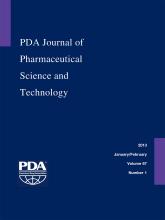Abstract
Pantoprazole sodium is a proton pump inhibitor used to treat peptic ulcers and gastroesophageal reflux. This drug is unstable in acid solution, in the presence of salts, as well as in UVC radiation. Hence the aim of present study was to develop microparticles that will protect the drug from degradation in gastric acid and increase its photostability. Microparticles were prepared by the solvent evaporation method using Eudragit S 100 as enteric polymer by varying drug: polymer ratios ranging from 1:1 to 1:4. The developed microparticles were characterized for surface morphology, particle size, encapsulation efficiency, and stability in acidic media. Microparticles obtained with the ratio 1:4 were spherical, had a smooth surface, and showed the highest percent entrapment of 67 ± 2.1%. Microparticles showed uniform size distribution; about 87% of microparticles were in the size range of 50 to 75 μm. In vitro dissolution studies showed no drug release in acidic media; further prolonged drug release for a period of 9 h was obtained with a 1:4 in phosphate buffer pH 7.4 following Higuchi release kinetics with regression value of 0.9896. Photodegradation studies were performed in solar light and in UV light at 254 nm and 366 nm for 7 days. The concentration of drug was determined spectrophotometrically at 290 nm. Percent degradation under solar light for pure drug was 25%, and no significant degradation was seen in drug-loaded microparticles. Degradation under UV radiation 254 nm and 366 nm was found to be 38.6% and 12.11% and 35.11% and 6.13% for pure drug and drug-loaded microparticles respectively.
LAY ABSTRACT: Pantoprazole sodium is widely used in treatment of acid-related disorders and management of gastroesophageal reflux diseases. It is an acid-labile drug that degrades in the stomach at pH 1–2 and is highly unstable in UVC light. Hence the aim of research work was to improve photostability of pantoprazole and protect it from the acidic environment by loading in gastroresistant microparticles. Various batches of microparticles were prepared by the solvent evaporation method using Eudragit S 100 as an enteric polymer that solubilizes at pH 7. Developed microparticles were characterized for different parameters and the formulation showing the highest drug entrapment was selected for photodegradation studies. Photodegradation studies were performed in solar light and in UV light at 254 nm and 366 nm for 7 days. The concentration of drug was determined spectrophotometrically at 290 nm. The percent degradation under solar light for pure drug was 25% and no significant degradation was seen in drug-loaded microparticles. Degradation under UV radiation 254 nm and 366 nm was found to be 38.6% and 12.11% and 35.11% and 6.13% for pure drug and drug-loaded microparticles, respectively. Microencapsulation decreases the penetration as well as absorption of radiation, which enhances the protection of pantoprazole sodium.
- © PDA, Inc. 2013
PDA members receive access to all articles published in the current year and previous volume year. Institutional subscribers received access to all content. Log in below to receive access to this article if you are either of these.
If you are neither or you are a PDA member trying to access an article outside of your membership license, then you must purchase access to this article (below). If you do not have a username or password for JPST, you will be required to create an account prior to purchasing.
Full issue PDFs are for PDA members only.
Note to pda.org users
The PDA and PDA bookstore websites (www.pda.org and www.pda.org/bookstore) are separate websites from the PDA JPST website. When you first join PDA, your initial UserID and Password are sent to HighWirePress to create your PDA JPST account. Subsequent UserrID and Password changes required at the PDA websites will not pass on to PDA JPST and vice versa. If you forget your PDA JPST UserID and/or Password, you can request help to retrieve UserID and reset Password below.






